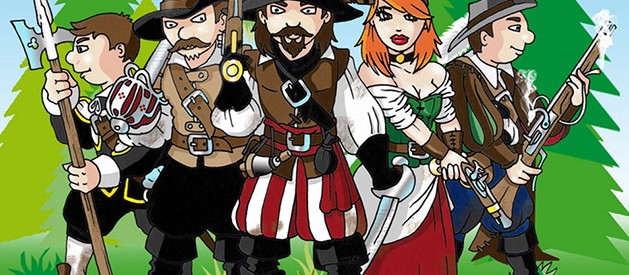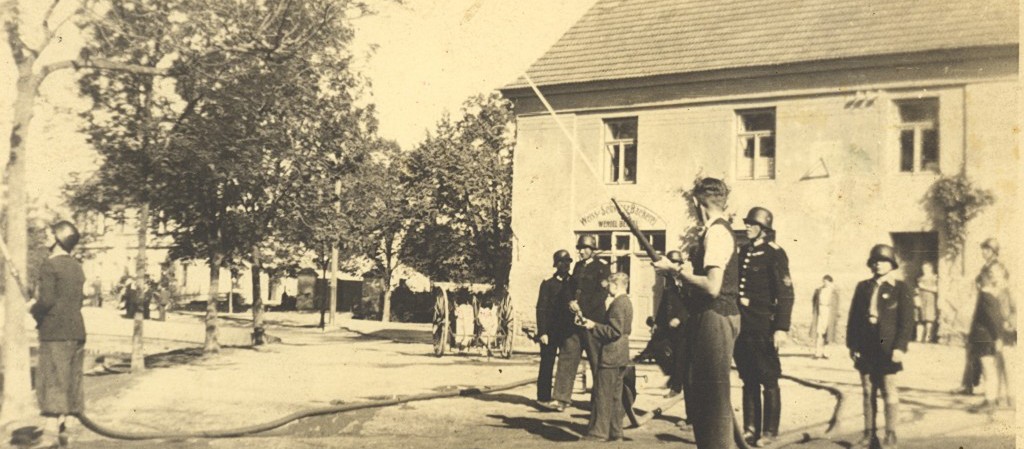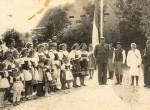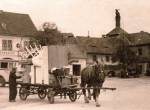
The educational journey of the robber Stetka
A nature trail around the surroundings of Štětí for the whole family, introducing the history and picturesque nature, industry and agriculture of Štetsko. The legendary robber Štětka and his four-member team are guiding the tour, giving information on a marked circuit starting from
In the old days of the Thirty Years' War, the robber Štětka was the master of the deep forests, fields and hillsides around the town of Štětí. Today, his home is the former Mordloch Cave, hidden away from people in the middle of the Stračen forests. Who knows him in the region. He protects the poor and honest, and justly punishes dishonesty and avarice. He has walked this land many times. He knows every road and footpath here.
During your adventurous journey with the robber Stetka you will come across educational boards that will tell you all about the history, nature, fauna and flora, industry and agriculture of the local region or visit the mythical cave Mordloch of the robber Stetka. You can also try out a discovery competition Following the footsteps of the robbers or robber geocaching.
Stops

Radouň
CZECH-GERMAN COEXISTENCE IN THE REGION OF STETTIN
Ethnic changes
At the end of the 1st millennium, the local landscape was undoubtedly inhabited by Czech ethnic groups. However, after the Thirty Years' War, during the 17th and 18th centuries, it was displaced by German settlers coming from the poorer borderlands to the north, closer to the more fertile centre of the Bohemian basin. The course of the Elbe River became a linguistic border in the region. After the establishment of Czechoslovakia in 1918, there was a return influx of Czech-speaking settlers, but after 20 years they were largely expelled again, first to the encircled Czech territories and then to the Protectorate of Bohemia and Moravia, established during the German occupation in 1939. After the Second World War, the German population was displaced to Germany and Austria, and so Stetland on the right bank of the Elbe, like the entire Sudeten German border area, began to become Czechised again. These ethnic changes did not affect the villages on the left bank of the Elbe, as specifically Hněvice and Račice in Stetland always remained Czech.
Year 1945
In June 1945, the first "wild" removal of about 300 German inhabitants to East Germany, occupied by the Soviet army, took place. These were mainly those families whose members were known to have been involved with Nazism and against Czechoslovakia. According to decrees issued by President Beneš, former German citizens were deprived of the most important civil rights, especially citizenship, and had to wear white armbands. Their property was confiscated on the principle that they had collectively participated in the break-up of Czechoslovakia in 1938. The confiscated property was to become part of the reparations for the damage caused to the Republic during the war.
At the beginning of August 1945, a large, organized removal of citizens of German nationality to Germany began. According to an eyewitness account, it took place in Štětí as follows:
"The night before we left, there was a lot of excitement in town. All the houses were lit up, the Czechs were on patrol, unnecessary or compromising things were burned in German homes until morning, and only the most necessary items were packed for the journey. After five o'clock in the morning the Germans began to gather in the square with their parcels, white armbands on their sleeves. Each was allowed to take only 30 kg of luggage on a handcart or in a baby carriage. In front of the courthouse, they handed over the keys to their houses. Then they made their last journey through the city. The procession took up the entire width of Station Street and slowly and obediently wound its way to the station. The tearful faces of the women and the clenched fists of the men. About 1,000 Germans gathered at the station. The loading of luggage lasted until the afternoon hours. The sun was scorching and the Germans in their warm clothes were baking with heat. It was only after 3 p.m. that the long train moved and after a while disappeared behind the vineyards of Stettin."
After the expulsion, about 100 Germans remained in Štětí, mainly in mixed marriages, and several demonstrable anti-Nazis. The Czech population moved into the empty houses. In September 1945, Štětí also welcomed several families of Viennese Czechs who had decided to repatriate to their old homeland from war-torn and impoverished Vienna after the war. The gap left by the displaced German citizens was slowly being filled, the town was Czech again after centuries, and conditions were consolidating.
In October 1945, the political parties of the National Front were established in the town and the management of the town was taken over by the Municipal National Committee. The parties elected Karel Lejnar, a peasant who had survived the German occupation with his family on their farm in Štětí, as its first chairman. The streets and squares were renamed, for example: Velké náměstí → Benesovo nám., Malé nám. → Husovo nám., Nádražní ul. → Stalinova Street, other new names were Masarykova, Lukešova, Horova, Komenského, Smetanova, etc. The naming of the area near the Catholic church after Hus was probably inspired by the wave of Czech post-war atheism and the inclination towards the national Czechoslovak Church. In the case of Dohnalova Street, there was also a minor mistake when the councillors left the street with a Slavic-sounding name after the once popular German doctor and mayor of 1869, MUDr. Heinrich Dohnal.
Changes of nationalities in municipalities
According to historical sources, at the end of the 19th century the vast majority of inhabitants in the municipalities of the Stettin region were of German nationality. The population of the same municipalities has significantly decreased in 2004 and is almost exclusively of Czech nationality.
| Village | Population | |
|---|---|---|
| end of the 19th century | year 2004 | |
| Brocno | 966 | 235 |
| Chcebuz | 909 mostly German | 200 |
| Radouň | 900 mostly German | 200 |
| Újezd | 188 | 44 |
| Veselí | 196 | 30 |
| Snědovice | 583 | 274 |
| Krešov | 348 | 48 |
| Střížovice | 239 | 95 |



